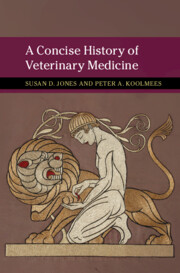Book contents
- A Concise History of Veterinary Medicine
- New Approaches to the History of Science and Medicine
- A Concise History of Veterinary Medicine
- Copyright page
- Contents
- Illustrations
- Tables
- Note on Translations
- Preface
- Introduction
- 1 Animal Healing in Sacred Societies, 1500–1700
- 2 Animal Healing in Trade and Conquest, 1700–1850s
- 3 Formal Education for Animal Healing
- 4 Veterinary Institutions and Animal Plagues, 1800–1900
- 5 Veterinary Medicine in War and Peace, 1900–1960
- 6 Food, Animals, and Veterinary Care in a Changing World, 1960–2000
- 7 Veterinary Medicine and Animal Health, 2000–2020
- Epilogue
- Book part
- Further Reading
- Index
3 - Formal Education for Animal Healing
From Riding Schools to Veterinary Schools, 1700–1850
Published online by Cambridge University Press: 11 August 2022
- A Concise History of Veterinary Medicine
- New Approaches to the History of Science and Medicine
- A Concise History of Veterinary Medicine
- Copyright page
- Contents
- Illustrations
- Tables
- Note on Translations
- Preface
- Introduction
- 1 Animal Healing in Sacred Societies, 1500–1700
- 2 Animal Healing in Trade and Conquest, 1700–1850s
- 3 Formal Education for Animal Healing
- 4 Veterinary Institutions and Animal Plagues, 1800–1900
- 5 Veterinary Medicine in War and Peace, 1900–1960
- 6 Food, Animals, and Veterinary Care in a Changing World, 1960–2000
- 7 Veterinary Medicine and Animal Health, 2000–2020
- Epilogue
- Book part
- Further Reading
- Index
Summary
Developments in international trade, colonialism, and conquest created the military needs (healthy army horses) and economic needs (controlling great animal plagues) that shaped the professionalization of modern veterinary medicine in Europe and beyond. This chapter analyzes how the circulation of veterinary knowledge was organized in the eighteenth and nineteenth centuries, amidst the challenges of animal disease outbreaks and battlefield injuries that had accompanied war and trade. It examines how modern veterinary schools emerged from European Enlightenment pragmatism and French physiocrat economics, and why and how this model of education spread around the world. State promotion and regulation of veterinary education and professionalization of veterinary practitioners increased, augmenting the traditional roles of herders and healers in many areas. Veterinarians educated in this formal European tradition slowly expanded their share of the market for veterinary services as their numbers and state-sponsored influence grew. The development and spread of the eighteenth-century European veterinary regime was a product of its time. It fulfilled crucial social, political, military, and cultural needs during subsequent decades of increasing industrialization and imperialism affecting the globe.
Keywords
- Type
- Chapter
- Information
- A Concise History of Veterinary Medicine , pp. 86 - 133Publisher: Cambridge University PressPrint publication year: 2022



